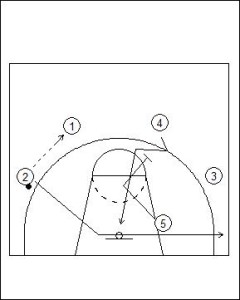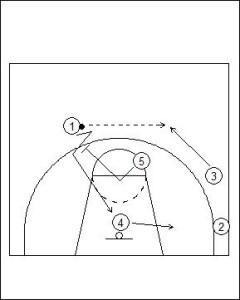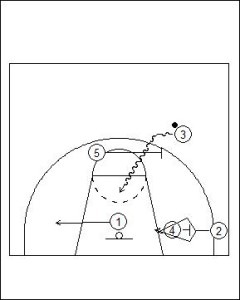Shuffle Offense: Dual Cut to On-Ball
The Shuffle Offense is always a favourite for rapidly shifting players from one side of the floor to the other with the Shuffle Cut. The Dual Cut to On-Ball Play is no different with the Shuffle Cut bringing a player away from the strong side of the floor to over load the weak side creating multiple cut opportunities to keep defenders always shifting and challenging their ability to establish good help defence positions.

The Shuffle Offense Dual Cut to On-Ball Play starts initially in a 4 out and 1 in formation. The ball starts from the sideline (Two) which is a typical position for the ball to finish after a team’s Primary Transition.
The ball is passed back towards the middle of the floor to One (1) and this triggers the initial Shuffle Cut by Two (2).
Five (5) flashes towards the ball, but never breaks the split line, so not to interfere with the passing lane from One (1) to Two (2). Five (5) once reaching the split line then sets an up screen for Four (4).
Four (4) creates a lead and cuts ball side of the screen set by Five (5).
Variation
- If no pass can be made Two (2) can always dribble up to the elbow extended. In this instance, One (1) would fill a cutting role to the basket.
Scoring Options
- The quick reversal of the ball from Two (2) to One (1) should create some advantage of speed over the defensive match-up (when executed at pace following the transition). This will assist with the effectiveness of the shuffle cut.
- Five (5) is a scoring threat and is isolated in the middle of the floor if the pass is initiated to the player. For strong facing up to the basket players this will be a very advantageous position.
- Following the cut from Four (4), Five (5) can present as a target and initiate a high-low action with Four (4) on the rim and Five at the foul line. In this situation, all the help defence will be outside the keyway except for the match-ups between Four (4) and Five (5).

As Three (3) lifts from the wing extended to the elbow extended; When Three (3) reaches the desired position One (1) reverses the ball with a pass across the top of the middle lane.
Five (5) again, creates a lead this time towards the basket before setting a back screen for One (1).
Four (4) moves out of the keyway and into a mid-range position outside of the short corner/low post.
One (1) creates a lead to the middle of the floor before going under the screen and cutting to the basket. Alternatively, this cut can be made to the ball side of the screen if the defender is not in the desire position.
Variation
- If three (3) is not able to break free of their defender then the player can use Five (5) to curl around and lift into the position desired.
- Additionally, Three (3) can always cut to the basket off a screen by Five (5) which triggers a lift by Two (2) into the elbow extended position.

Five (5) moves to set an on-ball screen for Three (3).
As Three (3) starts to move:
- One (1) pushes into a mid-range position on the weak side of the floor.
- Four (4) steps towards the Sideline to set a flex screen for Two (2).
Three (3) attacks the middle lane and dribbles into the keyway.
As Three (3) is coming over the shoulder of the screener; Two (2) needs to utilise the screen and be cutting to the basket.
Scoring Options
- Three (3) when driving to the basket should be expecting to make a jump shot from below the foul line rather than a lay-up.
- If One’s (1) defender sticks to the basket then a pass can be made while driving into the keyway by Three (3) for a short-range jump shot.
- Two (2) cutting over the flex screen.
Within the Shuffle Offense Dual Cut to On-Ball Play the high-speed movement of Three, One and Two should (if timed correctly) provide ample scoring options in the closing moments of the play.







